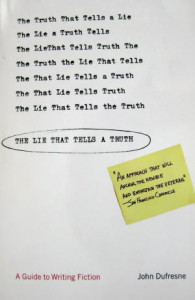Instruction With a Light Tone
 Dufresne, John. (2003). The Lie That Tells a Truth: A Guide to Writing Fiction. New York: W.W. Norton.
Dufresne, John. (2003). The Lie That Tells a Truth: A Guide to Writing Fiction. New York: W.W. Norton.
I met the author at a writing conference and decided to buy his book. It covers the basics that beginning writers need to know, such as how to make time in your day for writing, what to write about, how to develop characters, how to create a plot. All the bases are touched. Anyone starting out on the journey of writing fiction would be well-served.
While covering the basics, Dufresne keeps the tone light and conversational. I think it is important to be encouraging and positive with beginners, because the task of writing is severely daunting. To this end, every page of the book includes one or two epigrams, pithy quotes from writers and artists of all kinds, on aspects of writing and the creative life. “The purpose of art is the lifelong construction of a state of wonder.” – Glenn Gould. “Ever tried? Ever failed? No matter. Try again. Fail again. Fail better.” – Samuel Beckett. “Whenever possible tell the whole story of the novel in the first sentence.” – John Irving.
These quotations are of course merely opinions, many, such as Irving’s, of dubious validity, others too obscure to understand, but they’re fun, and that’s the point. Interestingly, Dufresne neglected to include an apposite quote from Albert Camus: “Fiction is the lie through which we tell the truth.”
Each chapter concludes with writing exercises, some of them interesting, most of them practical, which the author probably draws from his years of teaching writing. For example, “So today do the following: Read some opening scenes from books that you admire and try to figure out what is working there.”
On the downside, the author’s example texts go on far too long, and often do not even illustrate the point he was discussing. This is especially true when he cites his own writings, which is quite often. The citations are often so unfocused that they seem like mere filler, if not advertisements for his own published works.
Likewise, in the exercises, he is not content to explain the assignment, but fills up paragraphs and pages suggesting how the assignment might be fulfilled. For example, for the assignment just mentioned about reading opening scenes, he goes on at length to suggest these questions to consider: “What’s the date? Weather? Time? What are the sounds, the smells, the textures, the tastes, if any? What is your character thinking about? How does she feel? Mood? Who are the people in the scene?” And on and on and on, until you either have to scream or turn the page. Beginning writers are beginners, but they are not mentally incapacitated.
Despite these shortcomings, I still think that for a naive beginning writer of fiction, especially a younger one, this book will be harmless, yet informative and encouraging.
